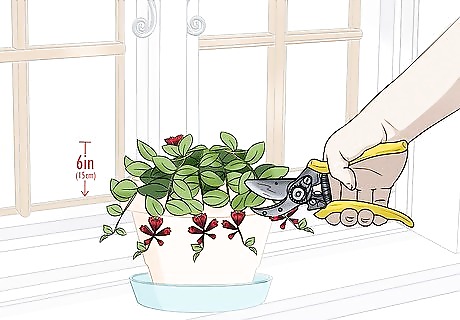
views
Helping Your Plant Grow

Use African violet potting mix combined with crushed charcoal. Lipstick plants originally grow in damp forest soil, so the best potting soil for them is one mixed with sphagnum that is kept moist, but not soggy. African violet potting mix combined with crushed charcoal is a good, commercially available mix for lipstick plants.

Place the plant in a very bright area, but not in direct sunlight. Choose a spot next to a south or west facing window to hang the plant, and place a sheer curtain between the plant and the window. Lipstick plants prefer indirect light, but it still needs to be very strong. This will help them flower.

Keep the room temperature between 65 and 70 degrees Fahrenheit during the spring, summer, and fall. As well, maintain a room humidity of between 25 and 49 percent. In the winter, keep the room temperature closer to 65 °F (18 °C) to encourage the plant to produce new flower buds. Do not hang the plant near a heating or air conditioning vent or near a doorway where it will be exposed to cold drafts in the winter.

Water the plant with “aged” room-temperature water during the spring, summer, and fall. Aged water is tap water that has been left sitting in an open container for at least 24 hours. Letting it sit allows the chlorine to dissipate. Water the plant with aged water when the top of the potting mix begins to dry. Pour the water evenly over the soil until it begins to drain from the bottom of the container—lipstick plants prefer to be watered thoroughly. To make aged water, simply fill an empty milk jug or watering can a few days before the lipstick plant needs to be watered. Then fill the container again right away after watering the plant. This way, you will always have aged water ready for the plant. Allow the top 2 inches (5.1 cm) of potting mix to dry before watering again. Keeping the lipstick plant a little dryer during the winter will result in more profuse blooming in the spring and summer.

Empty the catch saucer beneath the container every time you water the plant. Water should never be left in the saucer as it could soak back up into the potting mix and make the roots too wet.

Prune the lipstick plant back right after it finishes blooming. Pruning encourages new, healthy stems and leaves. Each stem should be trimmed back to a length of about 6 inches (15 cm). Use sharp scissors or hand pruners and make a cut right above a leaf. If the lipstick plant becomes straggly looking, which could be due to over- or under-watering or exposure to drafts, trim the longest vines back to as short as 2 inches.
Fertilizing and Repotting Your Plant

Give your plant fertilizer every two weeks during the spring, summer, and fall. As the plant will be actively growing and blooming during these seasons, you want to add fertilizer to encourage the plant’s growth and development. You can use water-soluble fertilizer with a ratio of 3-1-2 or 19-6-12 that contains micronutrients. Dilute the fertilizer at one-fourth the dilution rate recommended by the manufacturer. A common recommended dilution rate is about 1 teaspoon per gallon of water but, for lipstick plants, it should be about ¼ teaspoon per gallon of water.

Add the fertilizer solution to the plant by mixing it with lukewarm water at 1/4th the amount recommended on the package, unless you are using African violet fertilizer. Mix the water-soluble fertilizer in with the water instead of putting the fertilizer directly on the soil. You can also use slow-release houseplant fertilizer. Apply it according to the manufacturer’s instructions, usually 1 to 2 tablespoons (14.8 to 29.6 ml) per plant, and sprinkle it evenly over the potting mix.

Repot the lipstick plant when it becomes pot-bound to encourage better growth. A plant becomes pot-bound when the plant’s container is full of roots. The roots may also begin to grow out of the drain hole on the bottom of the pot or the plant may appear too large for its container. Select a container that is only 1 to 2 inches (2.5 to 5.1 cm) larger than the old container and make sure it has drain holes on the bottom. Pour 1 inch of African violet potting mix into the new container. Gently grasp the lipstick plant’s stems with your fingers at the soil line, tilt the container sideways, and pull the plant out of the old container. Use sharp scissors to snip off any excess roots growing out from the main root mass. Set the lipstick plant in the new container and finish filling it with African violet potting mix. Water it generously with aged water until the water drains from the bottom of the container.




















Comments
0 comment